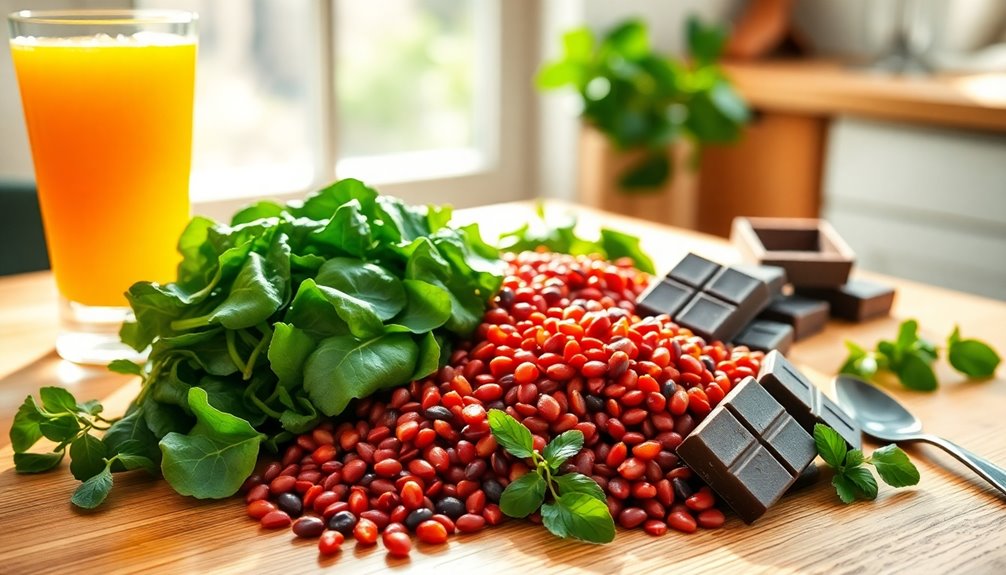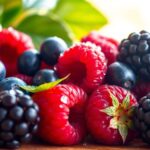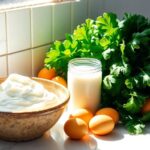If you want to boost your iron intake, focus on rich sources like beef, chicken, turkey, and pork for heme iron. For plant-based options, enjoy legumes, tofu, dark leafy greens, nuts, and seeds. To absorb iron better, pair these foods with vitamin C-rich items like citrus fruits or bell peppers. Beware of inhibitors like calcium and tannins from tea or coffee, as they'll reduce absorption. Cooking methods like steaming can also help. By combining these strategies, you can optimize your iron intake and improve health. There's much more to explore about iron's role in your diet for better overall wellness.
Key Takeaways
- Heme iron from animal products like beef, chicken, and pork is more efficiently absorbed than non-heme iron from plant sources.
- Enhance non-heme iron absorption by pairing it with vitamin C-rich foods like citrus fruits and bell peppers.
- Cooking techniques like steaming, sautéing, and using cast-iron cookware can improve iron absorption from foods.
- Avoid consuming calcium-rich foods, tea, and coffee during iron-rich meals to minimize absorption interference.
- Regular exercise, adequate sleep, and monitoring iron levels through blood tests support optimal iron absorption and health.
Importance of Iron in Diet
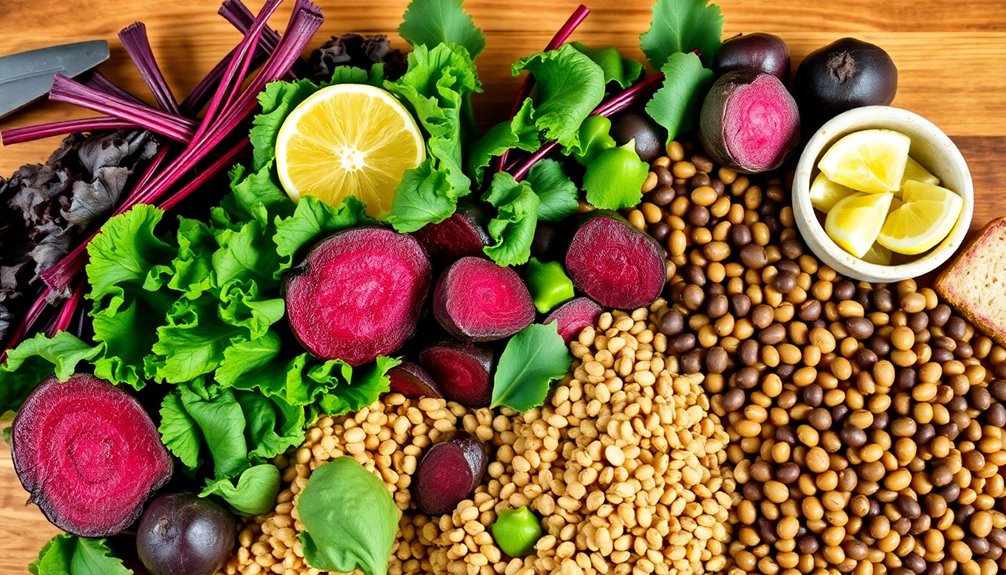
Iron plays an important role in maintaining your overall health, acting as an essential component in the production of hemoglobin, which carries oxygen in your blood. When your body doesn't get enough iron, you risk developing iron deficiency, leading to fatigue, weakness, and even cognitive issues. This deficiency isn't just a personal concern; it's a common issue that can affect anyone, especially those with specific dietary restrictions or increased needs, like pregnant women or athletes.
To ensure you're getting enough iron, it's crucial to understand how your body absorbs it. Iron absorption can vary based on several factors, including the type of iron in the foods you eat. There are two forms: heme iron, found in animal products, and non-heme iron, found in plant-based foods. Heme iron is absorbed more efficiently, while non-heme iron requires a little more attention. Following a plant-based diet, such as the 1 Month Vegan Challenge, can help you discover various sources of non-heme iron while also enhancing your overall health.
You can enhance your iron absorption by pairing non-heme iron sources with vitamin C-rich foods, like oranges or bell peppers. Cooking in cast iron pans can also increase the iron content of your meals. If you're worried about your iron levels, consider talking to a healthcare professional who can guide you on dietary choices and potential supplementation. Remember, maintaining adequate iron levels is vital for your well-being, helping you feel energized and engaged in your daily life. Prioritizing iron in your diet supports not just your physical health but your overall sense of belonging and vitality in your community.
Top Animal Sources of Iron
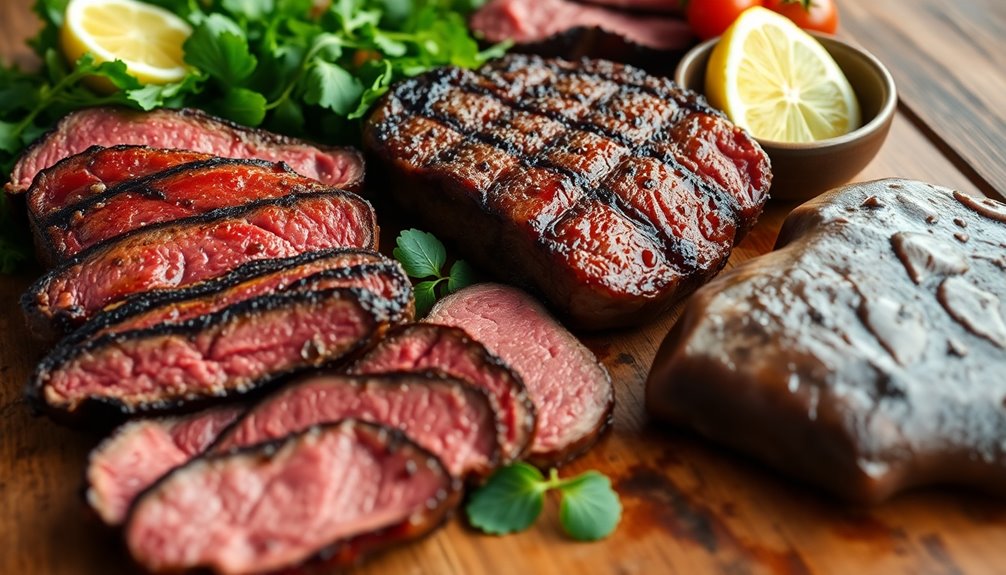
When it comes to boosting your iron intake, animal sources are among the most effective options available. The iron found in these foods, known as heme iron, is more readily absorbed by your body compared to non-heme iron from plant sources. Let's explore some of the top animal sources of iron and the best cooking methods to improve iron bioavailability.
| Food Source | Iron Content (mg per 100g) |
|---|---|
| Beef (ground) | 2.7 |
| Chicken (dark meat) | 1.3 |
| Turkey (dark meat) | 1.4 |
| Pork (chops) | 1.0 |
| Lamb (leg) | 1.6 |
Incorporating these foods into your diet can greatly help you meet your iron needs. Cooking techniques can also play a crucial role in maximizing iron absorption. For instance, grilling or roasting meats can retain more iron compared to boiling, which may leach nutrients into the water.
Additionally, pairing these iron-rich animal sources with vitamin C-rich foods, like bell peppers or citrus fruits, can further improve iron bioavailability. This combination can make a world of difference, especially if you're looking to address or prevent iron deficiency. By focusing on these top animal sources and employing efficient cooking techniques, you're setting yourself up for better health and higher energy levels. Moreover, ensuring you have whole food sources of protein in your meals can also support overall nutrient absorption.
Best Plant-Based Iron Sources
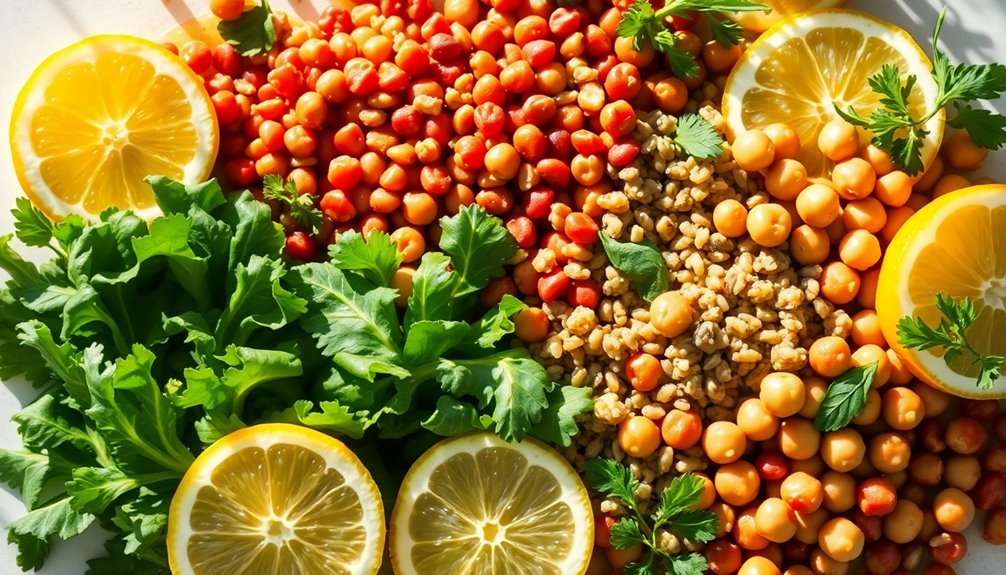
While animal sources provide a significant boost to your iron intake, plant-based foods can also contribute valuable amounts of iron to your diet. If you're exploring vegan alternatives or simply want to diversify your iron sources, here are some great plant-based options to explore:
- Legumes: Lentils, chickpeas, and beans are fantastic sources, packing a hefty amount of iron into each serving. Try adding them to salads or stews for a hearty boost.
- Tofu and Tempeh: These soy products not only offer a solid iron content but also fit perfectly into stir-fries and grain bowls. Their versatility makes them ideal for various cooking techniques.
- Dark Leafy Greens: Spinach, kale, and Swiss chard are rich in iron, especially when cooked. Sautéing them can enhance their flavor and make iron more bioavailable.
- Nuts and Seeds: Pumpkin seeds, cashews, and almonds aren't just snacks; they can also enrich your meals. Toss them into smoothies or sprinkle them over salads for an extra crunch.
Incorporating these plant-based sources into your meals can help you meet your iron needs while enjoying diverse flavors. Remember, using specific cooking techniques, like steaming or sautéing, can enhance the nutritional value of these foods. Embracing these options not only contributes to your health but also creates a sense of community among those seeking a plant-based diet lifestyles.
Factors Affecting Iron Absorption
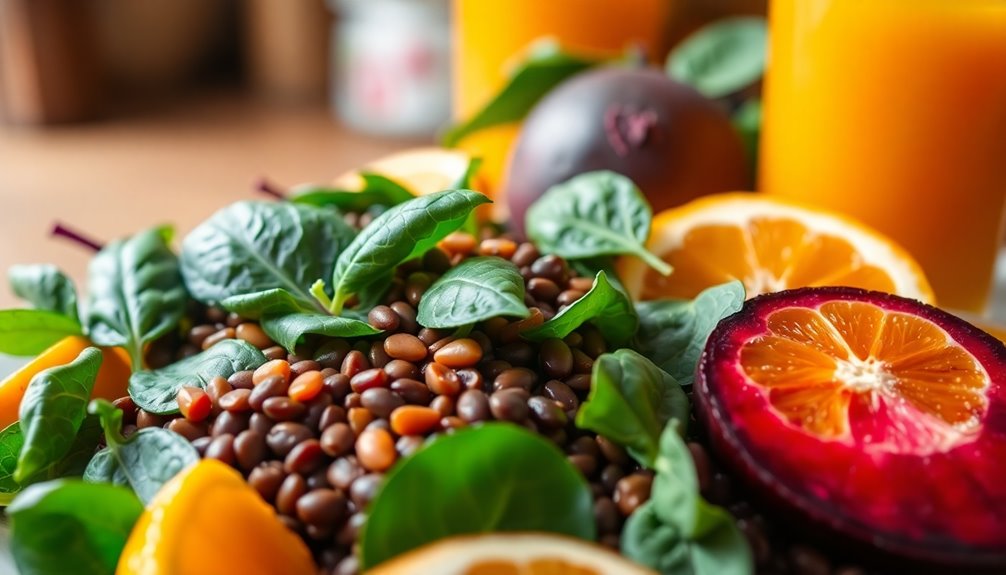
Understanding how your body absorbs iron is vital for optimizing your intake, especially if you rely on plant-based sources. Iron absorption can be influenced by several factors, both positively and negatively. You'll want to be aware of these to make the most of your nutritional choices.
First, let's talk about iron enhancers. Certain foods and nutrients can boost iron absorption significantly. For example, vitamin C-rich foods like oranges, strawberries, and bell peppers can enhance your body's ability to absorb non-heme iron, which is the type found in plant sources. Eating these alongside your iron-rich meals can make a tangible difference.
On the flip side, there are iron inhibitors that can hinder your absorption. Compounds like phytates, found in whole grains and legumes, can bind to iron and reduce its availability. Additionally, calcium, polyphenols in tea and coffee, and some antacids can also interfere with how well your body absorbs iron. If you're consuming these alongside your iron sources, you mightn't get the full benefit.
Being mindful of these factors can help you optimize your iron intake. By combining iron-rich foods with enhancers and being cautious of inhibitors, you can support your body's iron levels more effectively. This balance is especially important for those who follow plant-based diets, as understanding these dynamics can empower you to make healthier choices. Moreover, it's crucial to be aware of how certain foods, like traditional bread, can negatively impact your overall health and nutrient absorption, including iron.
Tips to Enhance Iron Absorption
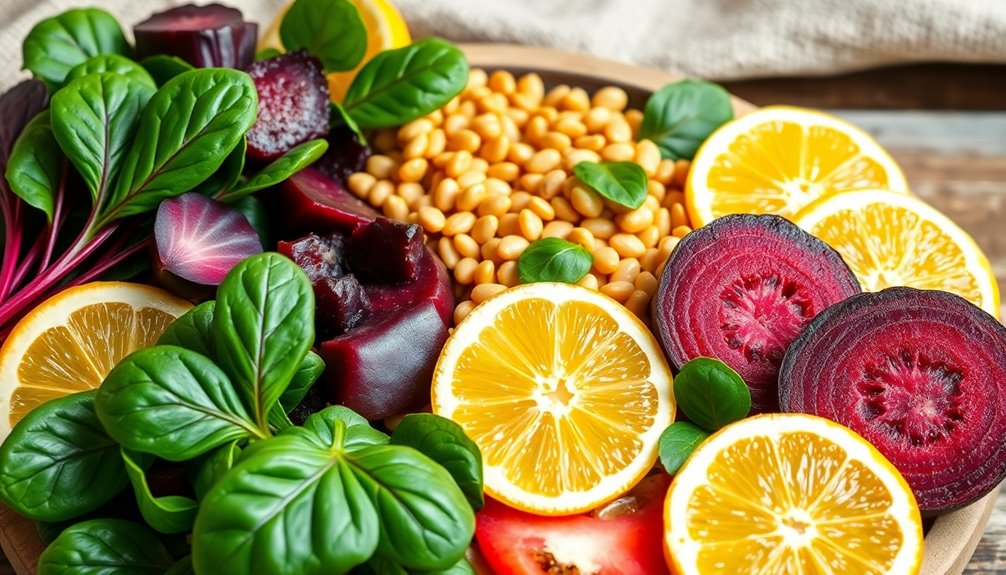
Maximizing your iron absorption is essential for maintaining peak health, especially if you rely on plant-based sources. Iron from plants, known as non-heme iron, isn't absorbed as efficiently as heme iron found in animal products. But don't worry! You can use a few tips to enhance absorption and make sure you're getting the most from your meals.
- Pair with Vitamin C: Consuming vitamin C-rich foods like oranges, bell peppers, or strawberries alongside your iron sources can significantly boost absorption. This synergy helps convert non-heme iron into a more absorbable form.
- Use Smart Cooking Techniques: Cooking methods like steaming, boiling, or sautéing can help break down plant cell walls, making iron more accessible. For example, cooking spinach reduces oxalates, which can impede iron absorption.
- Avoid Calcium and Iron Together: When possible, separate your calcium-rich foods (like dairy) from your iron sources. Calcium competes with iron for absorption, so it's best to enjoy them at different meals.
- Limit Tannins and Phytates: Be mindful of beverages like tea and coffee, as they contain tannins that can impede iron absorption. Likewise, whole grains and legumes contain phytates, so soaking or sprouting them can help reduce their impact.
Additionally, following natural calorie cycles can influence overall nutrient absorption, including iron, by promoting a balanced intake of essential foods.
Foods to Avoid With Iron
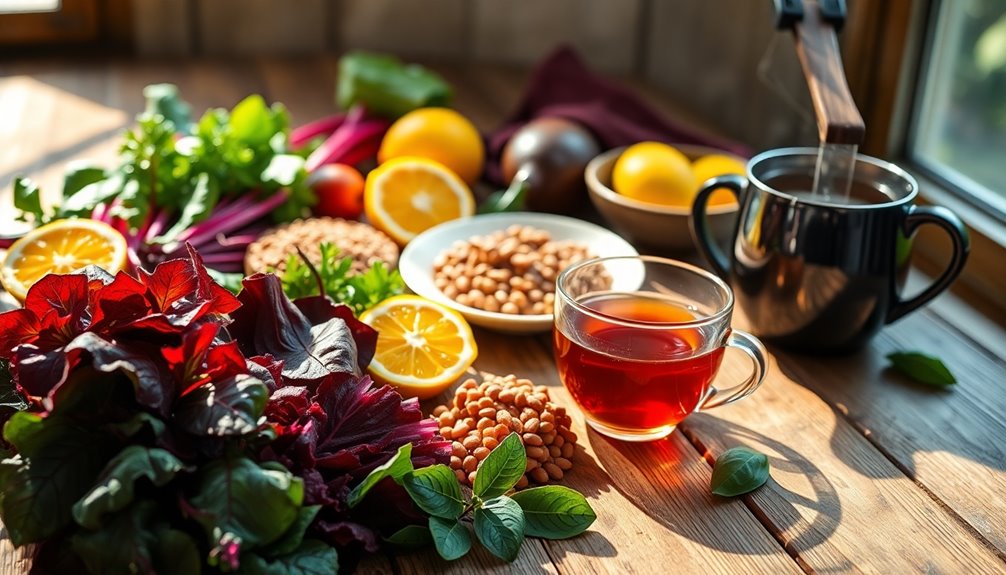
To optimize your iron intake, it's crucial to be mindful of specific foods that can hinder iron absorption. These foods, often known as iron blockers or iron inhibitors, can significantly impact how effectively your body utilizes the iron you consume.
One major group of iron inhibitors is those rich in calcium, such as dairy products. If you enjoy a glass of milk with your iron-rich meal, you could be reducing your body's ability to absorb that iron.
Similarly, foods containing tannins, like tea and coffee, can disrupt iron absorption. It's best to enjoy these beverages between meals rather than alongside iron-rich foods.
Phytates, present in whole grains and legumes, are another common iron blocker. So, while these foods are nutritious and offer fiber, you may want to adjust the timing of your meals. Consuming vitamin C-rich foods alongside iron sources can help counterbalance some of these inhibitors, but if you regularly consume large amounts of phytates, it may be wise to monitor your overall iron intake. Moreover, understanding how fatty liver can impact absorption is essential, as liver health influences the body's ability to utilize nutrients effectively.
Iron Supplements: What to Know
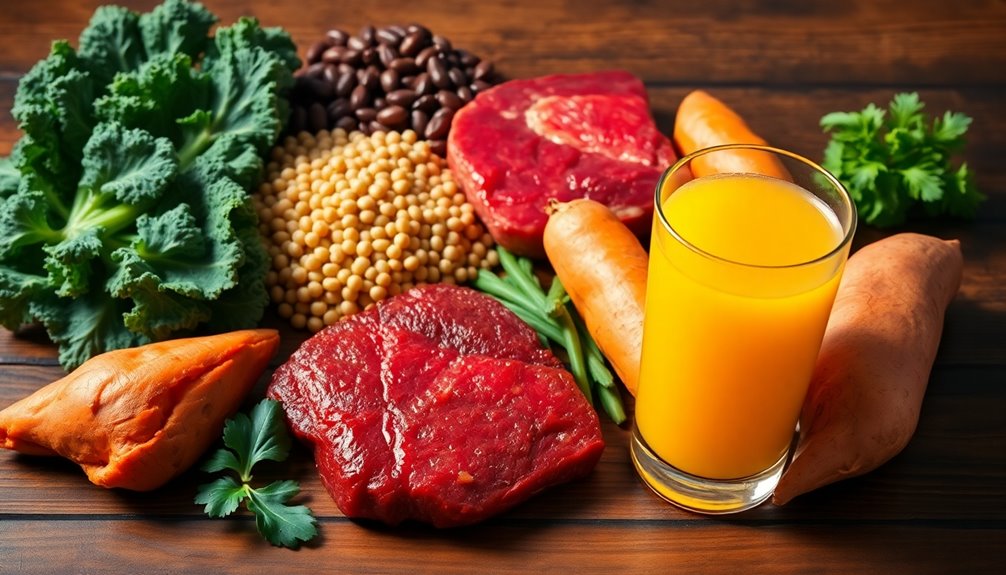
Iron supplements are often necessary for individuals who struggle to meet their iron needs through diet alone. If you're considering them, it's vital to understand the benefits and risks. Here's what you should know:
- Dosage Recommendations: Most adults need about 8-18 mg of iron daily. If you're supplementing, start with a lower dose and gradually increase it based on your doctor's advice.
- Benefits: Iron supplements can help prevent or treat iron deficiency anemia, improving your energy levels, cognitive function, and overall health. They can be especially advantageous for pregnant women, vegetarians, and athletes. Additionally, ensuring adequate oxygen intake can further enhance your body's ability to utilize iron effectively.
- Side Effects: While they can be helpful, iron supplements can cause side effects like constipation, nausea, and stomach cramps. If you experience severe discomfort, it's essential to consult your healthcare provider.
- Risks: Overloading on iron can lead to toxicity, particularly in children. Always stick to the recommended dosage, and avoid taking iron supplements without medical supervision unless you're sure you need them.
Frequently Asked Questions
How Does Cooking Affect Iron Content in Foods?
Cooking can greatly affect the iron content in foods. When you use methods like boiling, some water-soluble vitamins and minerals, including iron, may leach into the water, leading to reduced iron absorption.
However, techniques like grilling or steaming can help retain more iron. Incorporating foods rich in vitamin C alongside iron-rich meals can further enhance absorption.
Can I Get Enough Iron From a Vegan Diet?
Yes, you can get enough iron from a vegan diet by focusing on plant-based sources like lentils, chickpeas, and quinoa. To maximize absorption, pair these foods with vitamin C-rich options like citrus or bell peppers. If you're worried about your intake, vegan iron supplements can also assist. Just be sure to consult with a healthcare professional to guarantee you're meeting your needs while enjoying a fulfilling, plant-based lifestyle.
What Are the Symptoms of Iron Deficiency?
Imagine feeling like a car running on empty; that's what iron deficiency can do to you.
You might experience fatigue, weakness, or pale skin. These symptoms signal potential risks, including anemia.
To combat this, consider incorporating an iron-rich diet with foods like lentils, spinach, and fortified cereals. Pair these with vitamin C sources to boost absorption.
How Often Should I Get My Iron Levels Checked?
You should get your iron levels checked at least once a year, or more frequently if you're taking iron supplements or have a history of deficiency. Regular check-ups help maintain your levels stay balanced.
If you're incorporating iron-rich foods into your diet, it's essential to monitor your levels, especially if you're vegetarian or vegan. Keeping an eye on your iron levels helps you maintain overall health and well-being.
Are There Any Side Effects of Taking Iron Supplements?
Taking iron supplements can feel like adding fuel to a fire, but too much can lead to troubles. You risk an iron overdose, which can cause nausea or even organ damage. Plus, iron can interact with certain medications, diminishing their effectiveness or increasing side effects.
It's important to talk to your doctor before starting any supplements to make sure you're on the right path, keeping both your health and well-being in mind.
Conclusion
Incorporating iron-rich foods into your diet is essential for maintaining peak health. Whether you prefer animal or plant-based sources, understanding how to improve absorption can make a significant difference. Remember, it's not just about what you eat but how you combine those foods. By avoiding specific foods and considering supplements if necessary, you can guarantee you're not overlooking the opportunity on your iron intake. Prioritize these suggestions, and you'll be on the path to improved health!

